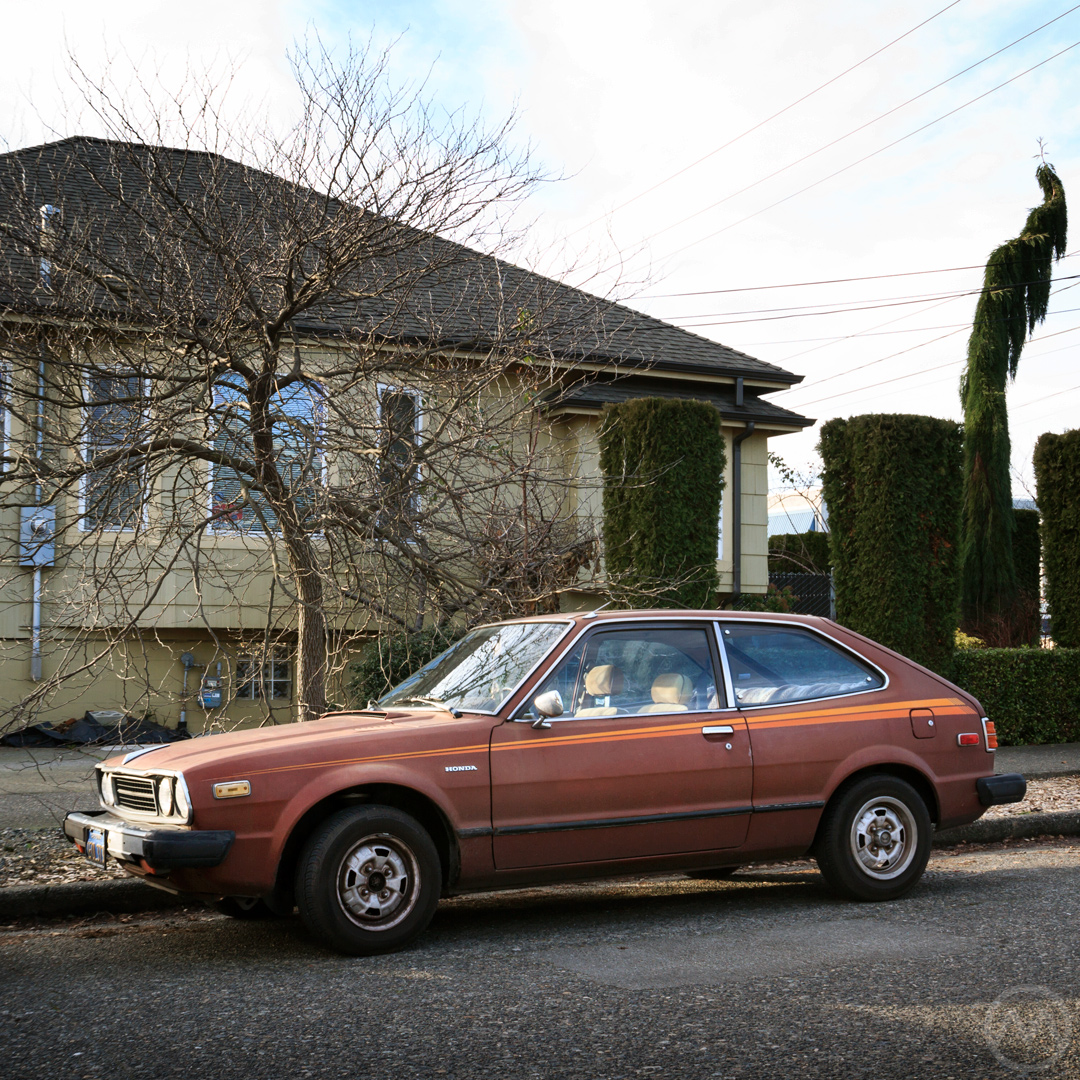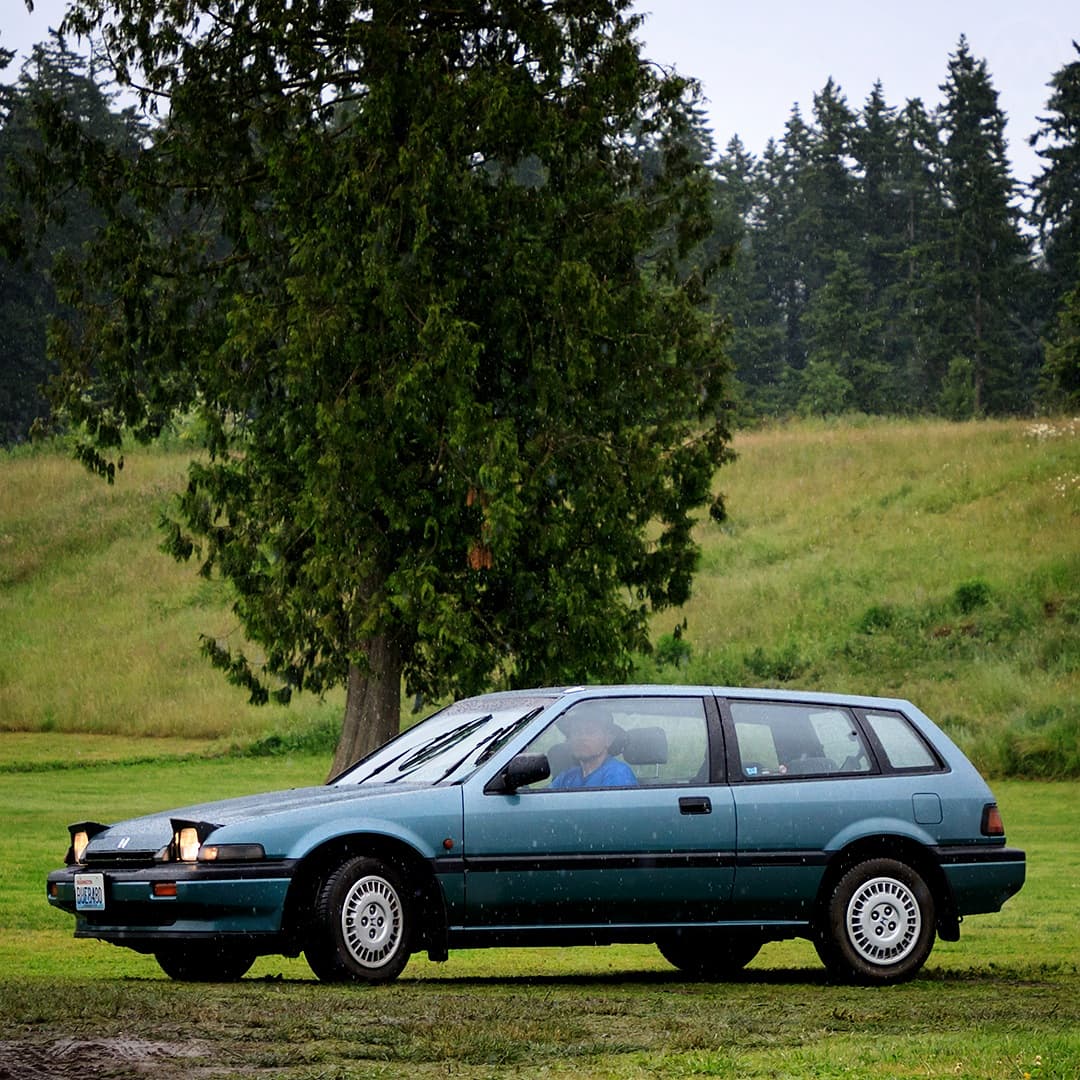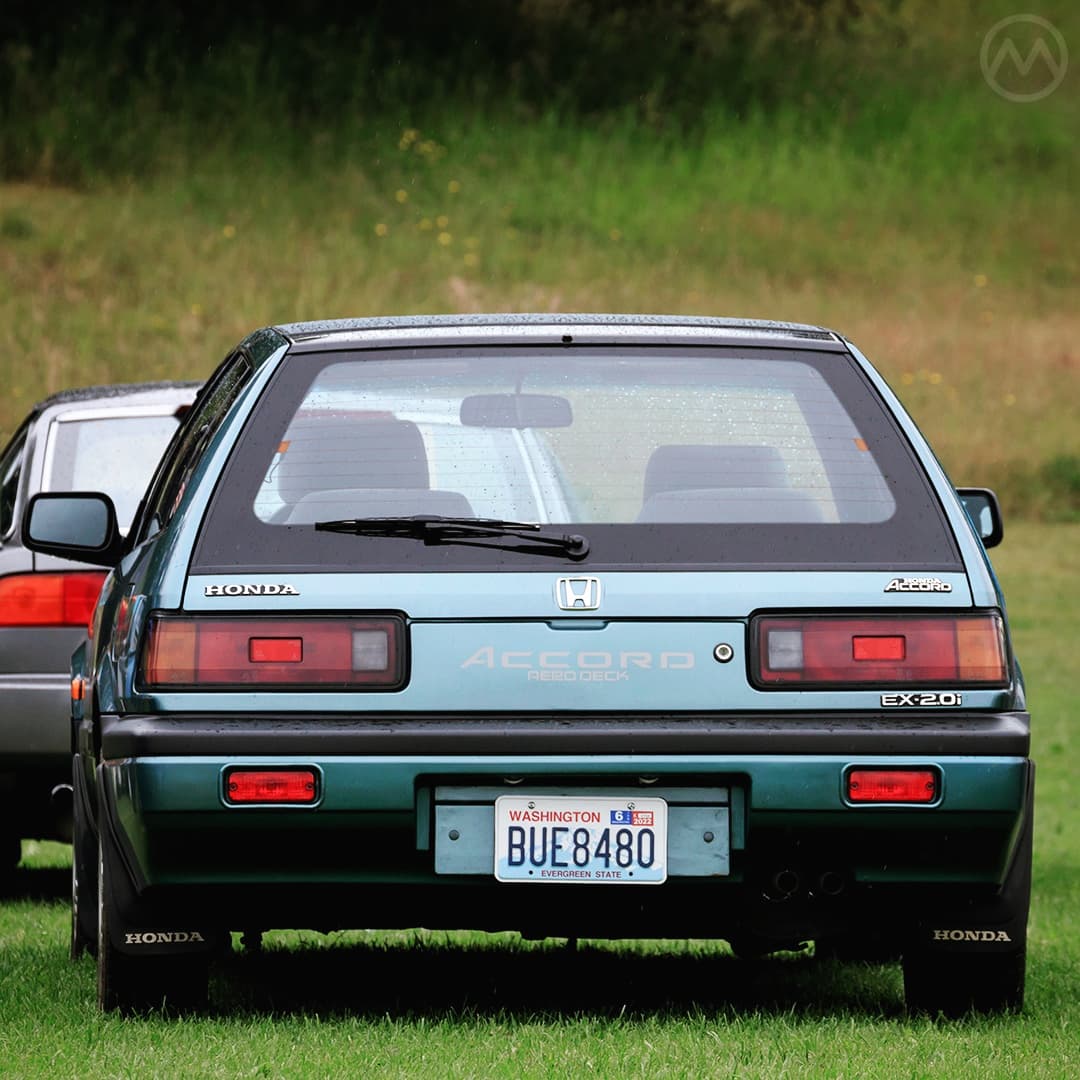At the end of the eighties the Honda Accord became America’s best-selling car, the first foreign car to achieve that title, though this Accord Aerodeck wasn’t involved in that particular quest. It was 1989. Honda had wrested the crown from Ford, who’s (U.S.) Escort had owned the top spot for the previous two years, largely on the strength of the Accord’s bona fides as a high quality family sedan.
That had been the Accord’s focus as a brand since the 1977 intro of the Accord four-door, but by the late eighties sales had reached such critical mass as to displace all the domestic family sedans at the top of the charts. Honda had introduced a U.S.-centric notchback coupe for this, the Accord’s third generation, so there was also a bit of new spice to the lineup.
But little known to U.S. consumers was an entirely different sort of Accord. In other markets, Honda offered the Accord Aerodeck, a stylish and upscale “shooting brake.” In concept it was not dissimilar to Volvo’s old 1800ES wagon or the Reliant Scimitar.
This was the first, and so far only, time in the Accord’s history that such an unusual model made it into the Accord lineup. Being an Accord, it was practical and reliable as death and taxes, but it was also a very unique and stylish car. Honda’s product planning decisions meant that it was mainly popular at home in Japan, but it was also sold in the U.K. and Europe.
Never offered in North America, only a handful have been imported over the years.This green Aerodeck is especially unusual as it’s a European-market left-hand drive example. The vast majority of Aerodecks were sold in right-hand drive locales.
The Hatchback Honda Accord
The Aerodeck was not only an unusual choice for Honda, it was also the first Accord station wagon. Starting in 1989 with the 4th-Gen Accord, the model would get a proper four-door family station wagon body (also labeled Aerodeck in some markets), but the third-generation Aerodeck was an inflection point in what the Accord was supposed to be and how it was marketed.
The original Accord of 1976 came only as a hatchback. While the original Civic got Honda the world’s respect as a carmaker, it was the first Accord that truly put it on the global map.The Accord bowed May of that year and within three months production had to be doubled. Demand outstripped supply, leading to multiple expansions at the Sayama factory.
Chief engineer Hiroshi Kizawa shepherded the creation of the new car, known internally as “Project 671,” through a new process labeled “S-E-D” for Sales, Engineering and Development, who all worked together to triangulate on the perfect balance between market appeal, technical dynamics, and cost and feasibility. This kind of triangulation made the Accord extremely user friendly, but to make its market even better, a sedan version was mooted even before production began. It arrived in 1977 and by the end of 1979 demand for the four-door had outstripped the original hatchback.
The second gen car, introduced in 1981, made only incremental changes to the formula in terms of the actual cars, though there was one major change. The second-gen Accord was the first Japanese car built in the USA, as Honda set up manufacturing ventures in local markets to expand production and insulate itself from trade barriers and currency issues.

The third-generation Accord was meant to make the car more dynamic looking and more upscale, which is in part where the Aerodeck came in. For the USA, however, things continued as before.
Patents for the Aerodeck were filed in the USA, but Honda would only build three-door hatches and four-door sedans for North America. Product planners judged the appetite for small two-door wagons to be too miniscule to federalize the Aerodeck, a decision later validated by other automakers’ experiences.
But hatchbacks were fading in the 1980s, and the three-door model was an ever-smaller slice of the pie. With sales failing to pick up in late 1985 with the introduction of the third-generation cars, Honda decided to add a notchback coupe to the U.S. lineup, which debuted in mid-1987. It used most of the pieces of the three-door, but with a shape Americans preferred.
Intended for the USA, the notchback was built at Honda’s factory in Marysville and, eventually, actually exported back to Japan. The three-door model was allowed to run its course, but was dropped forever at the end of 1989, and eventually all global Accord coupes came from Marysville.
The decision to build a notchback coupe for the U.S. was probably correct, as it proved a popular car for a long time, but in the meantime, North America missed out on the most unique version of the Accord.
Creating the Honda Accord Aerodeck
Underneath the skin, the Aerodeck is mechanically the same as all the other 3rd-gen Accords, a light and sharp-handling machine of Swiss-watch-like quality, but it was more eccentric in every way. Since the other Accords were such common cars, the little shooting brake stands out even more on U.S. roads.
The 3rd-gen Accord debuted in Japan in June of 1985 and in Europe and the USA later in the year. The hidden headlamps and low beltline made it look dramatically more modern and sporty than the square-rigged second gen car. The sedan was styled first, and the Aerodeck team reworked the platform for this unique version.
The design process is relatively unclear, but the overall styling for the third-gen Accord seems to have come from designers Kazuhiro Ichinose, who was directly involved with many diverse Honda designs over the years, including playing a role in the NSX and the original Honda Insight, and Toshi Oshika, who had also been involved in the more conservative design of the previous Accord. The three door model had a separate set of designers who worked from the A-pillar backward, as did the Aerodeck team. The three-door talent included Harumi Okano, who would later work on Civics, Integras, and the second-gen Acura CL coupe in 1999.
As with the other third-gen Accords, the internal process isn’t entirely clear, but the Aerodeck was created by taking the third-gen hatchback’s components and remaking them in a cost-effective but distinctive way. This is one reason why the Aerodeck’s tailgate is so uniquely shaped.
What we do know about the designers is that it was mostly the work of the same team that shaped the Mk3 Prelude. The Aerodeck was the work of Masato Nakano and Yusuke Saito, both of whom also worked on that car, along with Akio Koike, who went on to create the aesthetics of Honda’s ASIMO robot in the 1990s. They were based in Asaka, better known for designing Honda motorcycles, but there’s always been plenty of cross-pollination among Honda’s teams.

The shooting brake shape was an experiment to see if buyers would accept a kind of hybrid of wagon and hatch, and it was slightly shorter in overall length than the other third-gen Accords. Like the BMW E30 touring, the hatch opening does not extend down to the rear bumper for a low load floor. In BMW’s case, the E30 Touring got a small cutout from the structure to help loading, but Honda’s production budget likely didn’t allow for that, as some hard points had to be shared with the regular three-door.
Instead, the hatch extends into the roof and opens up like a single, perpendicular gullwing door. If you have to tool up for a whole new roof and hatch, why not? The result is a car with a big back seat, plenty of head room, and a very sporty look; but which isn’t as utilitarian as a conventional wagon. The actual cargo area is not all that much larger than the conventional 3-door hatch and the “Aero” wagon has a little more drag than the other Accords (a .34 cd to the other’s .32), but it sure did look good.
“Shooting brake,” an overused term now but once associated with wagons meant for sport (in the Pheasant-hunting sense) is an accurate description in this case. The Aerodeck displayed much of the same thinking as the aforementioned Reliant and Volvo products, but in much more modern clothes.
Reliant, as it happened, tried to go back to the drawing board to create a modernized Scimitar in the mid-1980s, but didn’t have the budget to build it, instead focusing on the Michelotti-styled SS1 roadster. But there were other cars in the Aerodeck vein at the time.
Selling the Aerodeck
Aerodecks were a little fancier than the regular Accords and even in Japan they were meant to cater to young, urban up-and-comers just like an E30 BMW. It came only with the 1.8 or 2.0-liter engines and the pop-up headlights (lesser models and the related Honda Vigor in some cases used regular lights) in Japan.
In Europe, they came only as 2.0-liter cars, either with Honda’s 122- or 137-horsepower A20A or, at the very end of the run, B20A engines. In Japan this latter engine boasted 158 horsepower, which was pretty good in the 2,400-lb. Aerodeck, though Euro-cars only got 137 horses.
The stylish wagon, like other Accords, was never intended to be a sporty machine like the Prelude, but it greatly benefitted from a totally new “twin cross member” suspension used by all of the third-gens. In practical terms it was just as sporty as an aging Scimitar and it felt it from the driver’s seat.
Speaking of the seats, the front seats in the Aerodeck were reportedly made under license from Recaro, and differ a bit from the standard Accord seats. Many JDM versions also featured electronic instrumentation, heated seats, power mirrors, and lots of other items that were real goodies back in 1986.

Alas, this creative and interesting machine did not continue after 1989. Aerodeck sales at home were decent but the market was limited. Honda wasn’t alone in creating a sort of miniature “lifestyle” wagon for the eighties (or early nineties), and many of these similar cars met a similar fate.
Nissan’s NX Pulsar, designed at Nissan Design International in California, also offered a wagon back, but theirs was interchangeable with a hatch that turned the car into a conventional coupe. Isuzu, and by extension Geo, offered a similar treatment on the second-generation Piazza/Impulse and related Geo Storm. Volkswagen briefly offered an altogether less glamorous 2-door wagon, the Fox, based on the Brazilian Gol/Parati, which had more in common with the Polo “Breadvan” than any of these more stylish machines.
As Honda had surmised, these manufacturers discovered that America’s appetite for small lifestyle wagons was not particularly large, and all were gone by 1994.
Starting in 1990, the “Aerodeck” label was applied to international versions of the much more conventional four-door Accord wagon, a model which was eventually phased out due to the popularity of Honda’s crossovers, particularly the CR-V. The original Aerodeck remains a unique chapter in Honda’s history and a practical and characterful classic.
We decided to expand our original social media posts on this car as this is the most popular item we’ve ever posted to Instagram. Do you have an Accord Aerodeck? Let us know!


I spotted this one, too! And I saw it at RADwood.
Great Article!
I was lucky enough to pick up a 1989 2.0 auto which I plan to restore.
I guess I’ll struggle getting spares because they’re very rare, but I’m looking forward to the challenge.
Ken
I drive one but the A20A in Euro never made 137bhp. Injected version only made 115bhp. Too bad Europe never saw the 16 valve B series.
Great handling car though not very practical to be honest.
My grandparents had this car back in the late 80s in the UK. I remember them picking me up from school aged 7, thinking how cool this car was. I realise now this is where my love of shooting brakes began.
Pingback: FMP – Cars from 2000-2010 – Janneke Games, Animation & 3D Modelling
Pingback: BMW 3200 CS, Honda Accord Aerodeck 2.0 Si, Lincoln Zephyr: Mercedes’ Marketplace Madness
Owned an Aero back when it was new.
The automatic was poor, saved by the ability to use it as a click-click semi-auto.
Otherwise nearly perfect, especially the beautiful engine and its compartment – like Faberge jewels, Honda at its absolute best.
Chopped it in for an estate, necessary for boats and bikes. Great car though, and I still miss it.
I have one in Ukraine. My first car. In totally bad condition but restoration process is done for 70%. Hope to ride it on weekend after some more fixes. If God will help us to win russia war than it would be great car for travelling.
I really wanted one of these back when I first got my license. It would have been old enough to be affordable, but unfortunately rust was merciless and Japanese’s cars especially suffered on our salted roads back then.
You forgot one car that I always thought of as a direct competitor in style, if not necessarily in sophistication. The Volvo 480 ES. A similar idea, but if I recall, essentially a mule for Volvo to test FWD on the public. Which means it’s one of the more important Volvo’s as it was the vanguard for post-900 series Volvos.